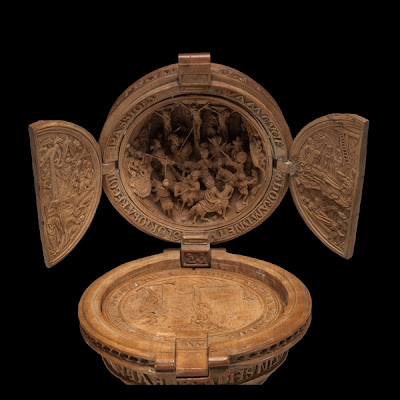The Netherlands, around AD 1500-30
The British Museum, London
 The Crucifixion
The Crucifixion Open full view
Open full view The Annunciation
The Annunciation
Of this precious exhibit in The British Museum, London, C.H. Read, in The Waddesdon Bequest: Catalog (1902) wrote:
"A rosary bead (sometimes referred to as a 'prayer nut' or 'paternoster bead') is characteristic of the minutely detailed, small-scale boxwood carvings used for private devotion.
These types of delicate and complex objects were owned by members of the nobility or wealthy merchant classes in northern Europe, and were highly prized as masterpieces of carving and invention.
A complete rosary, bearing the arms of England and probably dating to the first third of the sixteenth century, survives in the collections of the Dukes of Devonshire.
This spherical bead is carved on the outside with Gothic architectural detail, while the interiors are carved variously with scenes from the Old Testament and the New Testament.
The upper half is fitted with two doors, carved on both the inner and outer panels, which open to reveal the Crucifixion, crowded with miniscule figures in high relief.
The lower half is fitted with one door, carved on both sides and opening to reveal a complex scene showing the Bearing of the Cross.
The achievement of these perspectives in both low relief and in high relief attests to the great skill of the craftsman, who probably had to work using a magnifying glass."

No comments:
Post a Comment